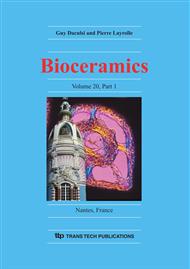p.897
p.903
p.907
p.911
p.915
p.919
p.923
p.927
p.931
Fabrication of Tailored Hydroxyapatite Scaffolds: Comparison between a Direct and an Indirect Rapid Prototyping Technique
Abstract:
In the last few years new fabrication methods, called rapid prototyping (RP) techniques, have been developed for the fabrication of hydroxyapatite scaffolds for bone substitutes or tissue engineering applications. With this generative fabrication technology an individual tailoring of the scaffold characteristics can be realised. In this work two RP techniques, a direct (dispense-plotting) and an indirect one (negative mould technique), are described by means of fabricating hydroxyapatite (HA) scaffolds for bone substitutes or bone tissue engineering. The produced scaffolds were characterised, mainly regarding their pore and strut characteristics. By these data the performance of the two fabrication techniques was compared. Dispense-plotting turned out to be the faster technique while the negative mould method was better suited for the fabrication of exact pore and strut geometries.
Info:
Periodical:
Pages:
915-918
Citation:
Online since:
November 2007
Price:
Сopyright:
© 2008 Trans Tech Publications Ltd. All Rights Reserved
Share:
Citation:


